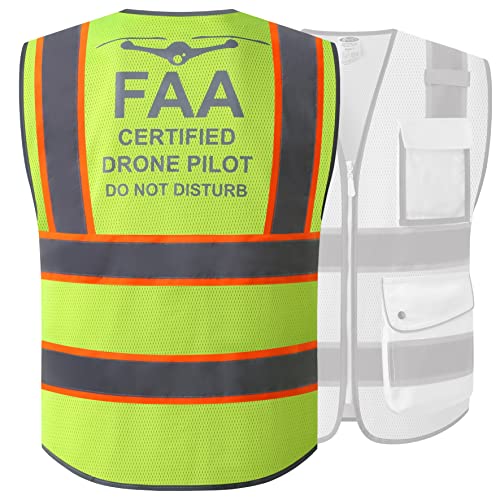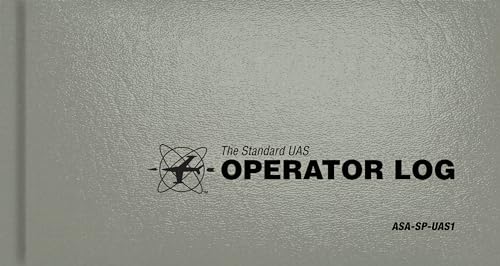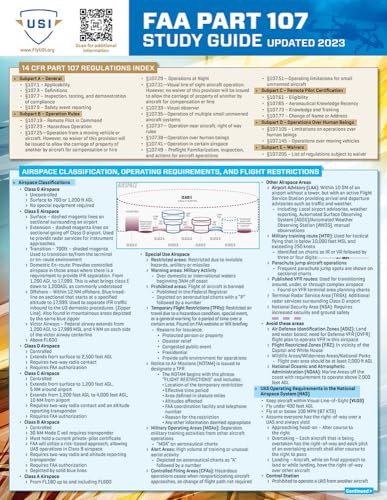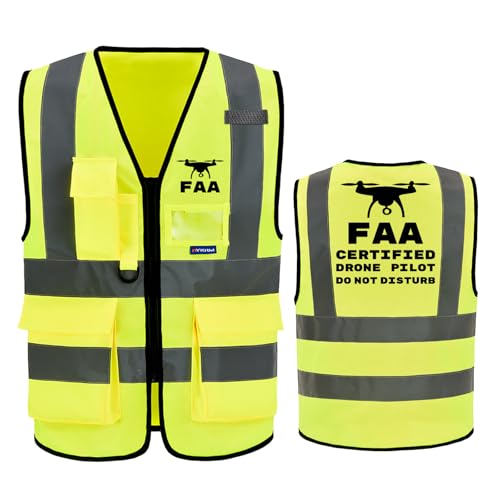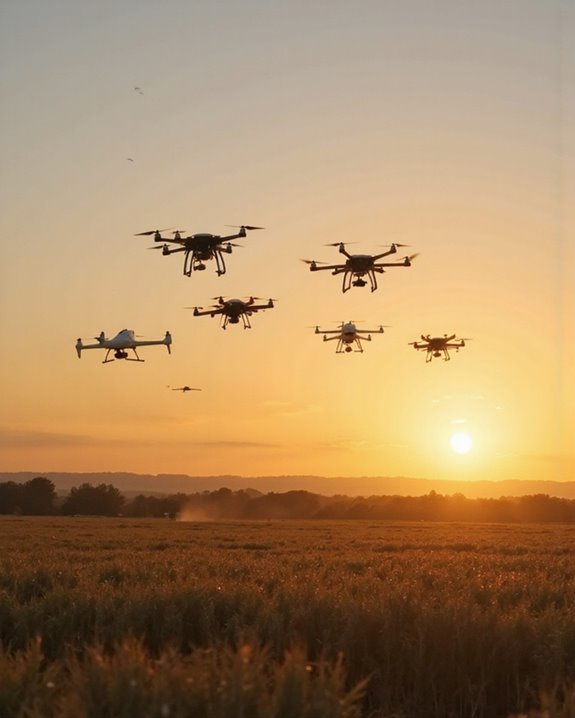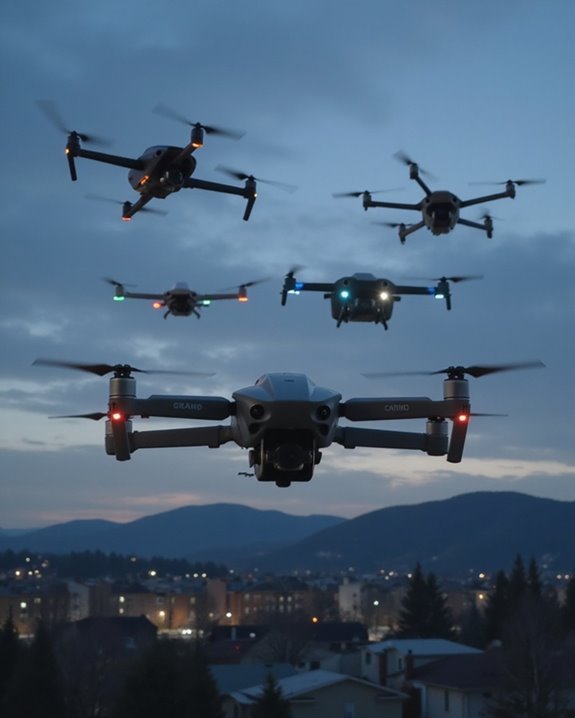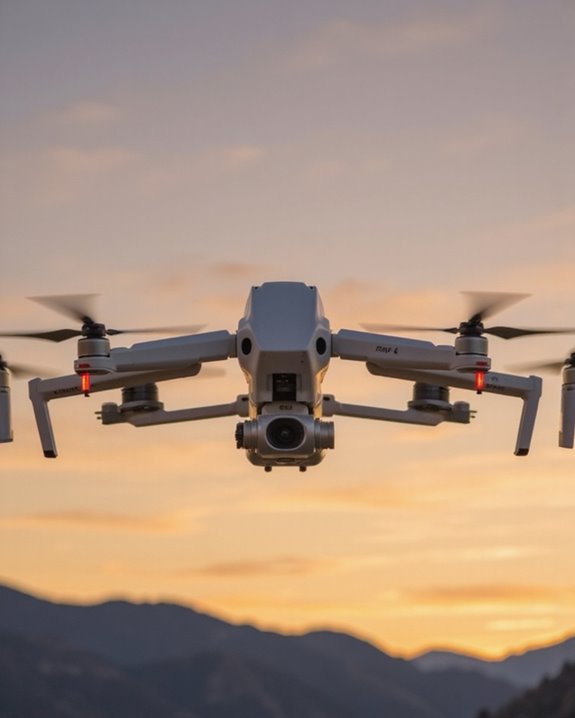Looking for top drone pilots in 2025? The best professionals combine essential qualifications: FAA Part 107 certification, 50+ logged flight hours, and experience in challenging conditions. They’ll have excellent equipment knowledge, maintain detailed flight logs, and wear proper safety gear like high-visibility vests. Great pilots also excel at communication and documentation—crucial for complex operations. Certification guides like “Remote Pilot Test Prep 2025-2026” help aspiring pilots join these elite ranks. Discover what separates average operators from aerial photography masters!
Key Takeaways
- The best drone pilots hold valid Part 107 certification with recurrent testing compliance, detailed flight logs, and thorough knowledge of regulations.
- Top drone photographers demonstrate mastery of challenging flight conditions, with 50+ logged hours and experience in night operations.
- Elite pilots maintain comprehensive equipment knowledge, performing regular firmware updates and pre-flight inspections while carrying necessary protective gear.
- Safety-conscious operators always wear high-visibility vests, conduct thorough pre-flight checks, and understand airspace restrictions.
- Superior drone pilots possess excellent communication skills, maintain meticulous documentation, and can troubleshoot technical issues on-site.
JKSafety FAA Licensed Drone Pilot Safety Vest
- MATERIALS: Breathable Mesh FAA Drone Pilot Reflective Safety Vest, Heavy Duty zipper, Light in Weight, Durable, Machine Washable in Cool Water. If you prefer a...
- HIGH VISIBILITY AND 360° REFLECTIVITY: Fluorescent Yellow body color Mesh Safety Vest | Sleeveless PPE | High Visible Four 2-Inches wide Reflective Strips Orange...
- 9 MULTI-FUNCTION POCKETS DESIGNED FOR CONVENIENCE: Total 9 multi-functional frontal pockets | 2-Tiers PVC transparent ID badge pocket | Pouch for small flashlight |...
When visibility means the difference between safety and risk, the JKSafety FAA Licensed Drone Pilot Safety Vest stands out as the essential gear for professional drone operators working in public spaces. You’ll appreciate the 9 multi-function pockets that perfectly store your batteries, tools, and other drone essentials while you’re capturing those award-winning aerial shots.
The high-visibility fluorescent yellow with orange trim isn’t just stylish—it’s ANSI/ISEA 107 Class 2 compliant! The breathable mesh design keeps you comfortable during those long summer flights, and the 360° reflectivity guarantees you’re visible from any angle. At just 8 ounces, you’ll barely notice you’re wearing it, but others will definitely notice you!
Best For: FAA licensed drone pilots who need high visibility, ample storage, and professional appearance while operating in public spaces or low-light environments.
Pros:
- Features 9 multi-function pockets perfectly sized for drone batteries, tools, and accessories
- ANSI/ISEA 107 Class 2 compliant with 360° reflectivity and high-visibility fluorescent yellow/orange design
- Lightweight (8 ounces) and breathable mesh construction for comfort during extended flight sessions
Cons:
- Sizing runs small – manufacturer recommends ordering 1-2 sizes larger than normal
- Some users report the vest may be too warm for extended use in hot climates
- Made in China, which may be a concern for those preferring domestic manufacturing
The Standard UAS Operator Logbook: ASA-SP-UAS1 (Standard Pilot Logbooks)
- Hardcover Book
- English (Publication Language)
- 104 Pages - 10/13/2015 (Publication Date) - Aviation Supplies & Academics, Inc. (Publisher)
Professional drone pilots know that meticulous record-keeping separates the amateurs from the elites in 2025’s competitive UAS industry! The Standard UAS Operator Logbook (ASA-SP-UAS1) is your essential companion for documenting everything from flight hours to maintenance checks.
You’ll appreciate the detailed format with dedicated columns for takeoffs, landings, and flight durations. With space for 329 entries, you can track certificates, airspace authorizations, and special missions all in one sturdy, compact hardcover book. Sure, you might need to modify a few column headers (goodbye, irrelevant “instrument flight conditions”!), but this FAA-recommended logbook ultimately helps lower your insurance rates and proves your professionalism when landing those premium gigs!
Best For: Professional and aspiring commercial UAS operators seeking to maintain comprehensive flight records, demonstrate experience to potential clients, and comply with FAA recommendations under 14 CFR 107.7.
Pros:
- Durable hardcover with 329 log entries (47 pages with 7 entries each) provides ample space for comprehensive record-keeping
- Includes dedicated sections for tracking certificates, maintenance, firmware updates, and special mission details
- Proper documentation can help lower insurance rates and provide valuable evidence during FAA/NTSB investigations
Cons:
- Contains redundant and irrelevant columns designed for traditional aircraft (instrument flight conditions, fixed wing hours)
- Missing important UAS-specific categories like weather conditions, visibility, and battery tracking
- Requires modifications to column headers and format for optimal use with small UAS operations
Remote Pilot Test Prep 2025-2026: Study Guide for FAA Exam
- ASA Test Prep Board (Author)
- English (Publication Language)
- 264 Pages - 09/30/2024 (Publication Date) - Aviation Supplies & Academics, Inc. (Publisher)
Aspiring drone pilots looking to ace their FAA certification on the first try have found their secret weapon! The Remote Pilot Test Prep 2025-2026 study guide delivers exceptional results, with users consistently reporting first-attempt passes and impressive scores like 88%.
You’ll appreciate this well-written, thorough resource that covers everything needed for Part 107 certification. The improved format over previous editions makes studying more intuitive, though you might wish the aeronautical maps were larger. For thorough preparation, many pilots supplement with additional charts, creating an unbeatable study system.
It’s absolutely worth the investment—just check that your copy arrives in pristine condition, as some users reported receiving damaged books!
Best For: Aspiring drone pilots who need comprehensive preparation materials to pass the FAA Part 107 certification exam on their first attempt.
Pros:
- Comprehensive content covering all necessary material for the FAA Part 107 certification
- Updated format that improves studying experience compared to previous editions
- High success rate with users reporting first-try passes and scores as high as 88%
Cons:
- Some aeronautical maps could be larger for better visibility
- Quality control issues with some copies arriving damaged or used
- May require supplemental chart materials for complete preparation
FAA Part 107 Drone: A QuickStudy Reference Guide
- Unmanned Safety Institute (Author)
- English (Publication Language)
- 6 Pages - 05/01/2019 (Publication Date) - Unmanned Safety Institute (Publisher)
Serious drone pilots who’ve mastered the skies don’t just fly by instinct—they know the rules inside and out. That’s why the FAA Part 107 Drone QuickStudy Reference Guide has become a must-have companion for top-tier aerial photographers and commercial operators.
This laminated trifold packs a powerful punch, covering everything from airspace classifications to emergency procedures in a concise, organized format. You’ll appreciate its quick-reference capabilities before exams and during flight planning! The guide even includes the latest Remote ID requirements (effective Sept 2023), though some users note the font runs a bit small. Whether you’re studying for certification or need an on-the-go refresher, this practical cheat sheet delivers the regulatory knowledge that separates amateur flyers from true aerial professionals.
Best For: FAA Part 107 exam candidates, licensed drone pilots seeking a quick regulatory reference, and professional operators wanting a compact summary of drone operating requirements.
Pros:
- Comprehensive coverage of essential drone regulations in a compact, laminated trifold format
- Updated with the latest Remote ID requirements effective September 2023
- Highly organized format praised by pilots who passed their Part 107 exam on the first attempt
Cons:
- Font size is too small for some users, potentially requiring magnification
- Some users report that the actual FAA exam included questions not covered in the guide
- May need supplementation with more detailed study materials for complete exam preparation
Reflective Security Safety Vests Heavy Duty with 7 Pockets and Front Zipper
- HIGH VISIBILITY APPAREL: A-SAFETY 7 pockets reflective safety vest with high visibility neon color.100% polyester material is lightweight and durable. There are 2'' wide...
- 7 MULTI-FUNCTION POCKETS:There are 7 front pockets bring you great convenience including 4 lower pockets.They are designed to easy categorization and easy access for...
- FEATURES:High reflective, lightweight and comfortable, breathable, foldable, easy to carry, multiple colors available. This is true by day and night and in inclement...
Top-tier drone pilots understand that visibility and organization can make or break a successful shoot! You’ll love these high-quality reflective vests that effectively deter curious onlookers from up to 50 feet away. The well-made construction features seven practical pockets, including a clear one perfect for displaying your drone license while in the field.
What sets these vests apart is the smart design—black lettering for maximum visibility without distracting fluorescence, and a convenient front zipper with a pull tab on the right side. They’re a game-changer for your drone gigs! Properly fitted and built from nice quality material, these vests deliver exceptional value that’ll keep you organized and looking professional on every shoot.
Best For: Professional drone operators seeking a high-visibility vest that deters onlookers while offering practical storage and professional appearance during shoots.
Pros:
- High-quality construction with seven functional pockets, including a clear pocket for displaying drone license credentials
- Black lettering provides maximum visibility without distracting fluorescence, effectively deterring curious people from up to 50 feet away
- Front zipper design with right-side pull tab offers convenience while maintaining a proper, comfortable fit during drone operations
Cons:
- No mention of reflective properties for nighttime visibility or low-light conditions
- Limited color options mentioned, which may not suit all professional environments or personal preferences
- No information provided about washing instructions or durability over time with regular use
Factors to Consider When Choosing a Drone Pilot
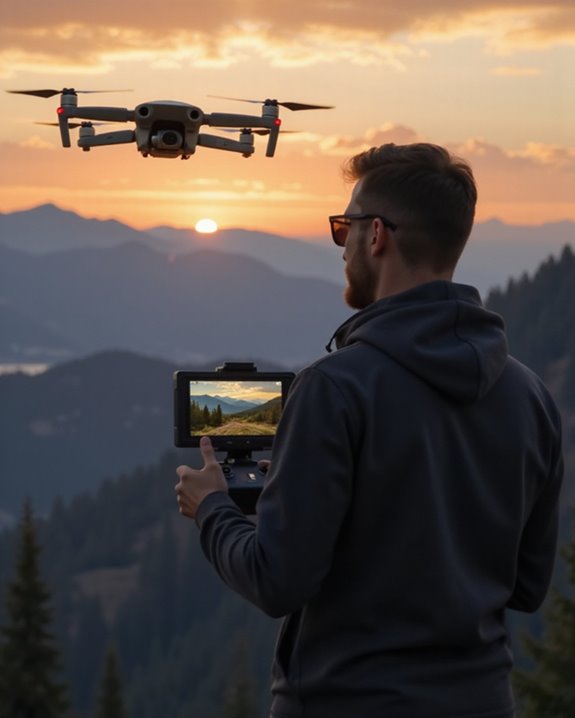
Selecting the right drone pilot for your project isn’t just about finding someone with a cool controller—it’s about verifying their qualifications and capabilities! You’ll want to evaluate their licensing and certification status, experience level, equipment knowledge, safety protocol understanding, and communication skills before making your decision. When you hire a pro who ticks all these boxes, you’re not just getting amazing aerial footage, you’re investing in a seamless, safe operation that delivers exactly what you need.
Licensing and Certification Requirements
The regulatory landscape for drone operations isn’t just bureaucratic red tape—it’s your first line of defense against legal troubles and safety hazards! When hiring a drone pilot, always verify they hold a valid remote pilot certificate, which they’ve earned by passing a thorough knowledge test covering regulations, airspace classification, and emergency procedures.
Your chosen pilot should be at least 16 years old and fluent in English, meeting all federal requirements. Remember, these certificates expire every 24 months, so check that your pilot has completed their recurrent testing on schedule—nobody wants a pilot with lapsed credentials showing up for your project!
Don’t forget to ask about their flight logs too. Under Part 107, professional pilots must maintain detailed records of each flight—a well-organized logbook is often the mark of a true pro!
Experience Level Assessment
Beyond mere certification, a pilot’s hands-on flight experience reveals the true story of their capabilities! When evaluating potential drone operators, you’ll want to examine their logged flight hours—those with fewer than 10 hours are still finding their wings, while pilots boasting 50+ hours typically demonstrate confident intermediate skills.
Don’t just look at the numbers, though! Check whether they’ve mastered challenging conditions like gusty winds or night operations. Has your candidate handled both multirotor and fixed-wing drones? That versatility speaks volumes!
The most reliable pilots can point to hundreds of successful takeoffs and landings, showing they’ve developed that sixth sense for precision flying. And remember, those who’ve aced standardized knowledge exams often bring a structured approach to safety that’ll keep your project—and your drone—from unexpected landings!
Equipment Knowledge Breadth
A thorough grasp of drone equipment sets elite pilots apart from the merely competent! When selecting your pilot, you’ll want someone who understands far more than just basic controls. Top-tier professionals can discuss various unmanned aircraft systems in detail, comparing specifications and capabilities for your specific needs.
Look for pilots who maintain detailed flight logs and can explain their maintenance protocols, including firmware update schedules and pre-flight inspection routines. They should confidently discuss their personal protective equipment choices—from high-visibility vests to specialized accessories for challenging environments.
The best pilots of 2025 stay current with industry resources, too! Their knowledge of technical manuals, regulatory guides, and emergency procedure references shows dedication to their craft. Remember, a pilot who can troubleshoot equipment issues on-site might just save your project timeline!
Safety Protocol Understanding
Safety protocols transform capable drone pilots into exceptional ones! When evaluating potential pilots, you’ll want someone who’s well-versed in FAA’s 14 CFR Part 107 regulations, which govern everything from airspace restrictions to weather limitations. The best pilots prioritize visibility by wearing ANSI/ISEA 107 Class 2 compliant gear, especially in challenging light conditions – because a visible pilot is a safer pilot!
Look for professionals who maintain meticulous flight logs tracking hours, maintenance, and emergency procedures. These aren’t just boring paperwork; they’re their safety résumé! Top-tier pilots conduct thorough pre-flight inspections, checking aircraft loading and developing backup plans for when things go sideways. They’ll also understand how fatigue and stress affect decision-making – because sometimes the safest flight is the one that doesn’t happen today!
Communication Skills Evaluation
Communication skills differentiate good drone pilots from truly exceptional ones! When evaluating potential pilots, you’ll want to assess their Crew Resource Management (CRM) proficiency, which reveals how effectively they exchange information during team operations. Check their flight logs for meticulous documentation—are takeoff locations, landing conditions, and mission details recorded with precision?
Don’t overlook verbal communication abilities! Put candidates through simulated radio scenarios to verify they’re using standard phraseology that prevents costly misunderstandings. Their written reports should be clear, complete, and error-free—no room for confusion in this high-stakes field!
Finally, ask about their emergency procedure experience. The best pilots can transmit critical information about weather changes or equipment issues with calm efficiency. Remember, in drone operations, clear communication isn’t just professional—it’s a safety essential!
Frequently Asked Questions
How Much Do Professional Drone Pilots Typically Earn?
You’ll be thrilled to know that 64% of professional drone pilots earn between $50,000-$85,000 annually! Your earnings will vary based on your specialty, with real estate photography starting around $45,000 while industrial inspection pilots often command $75,000+. If you’re considering this career, you’ll need FAA certification and specialized skills that clients value. Many pilots also boost their income through stock footage sales, creating multiple revenue streams from their breathtaking aerial work!
What Insurance Do Drone Pilots Need for Commercial Work?
You’ll need liability insurance as your core coverage for commercial drone work, protecting you from property damage and bodily injury claims. Don’t forget equipment insurance too—those high-end drones aren’t cheap to replace! Many clients require $1-2 million in coverage before you can even start shooting. Hull insurance, professional indemnity, and cyber liability are also worth considering, especially if you’re capturing sensitive data. Check out BWI or SkyWatch for drone-specific policies!
Can Drone Pilots Work Internationally With Their Certification?
Working internationally with your drone certification isn’t as simple as packing your gear and hopping on a plane! You’ll need to research each country’s specific drone regulations, as your home certification typically won’t transfer directly. Many nations require visiting pilots to obtain local permits, register their equipment, or even take country-specific tests. Some places, like Canada and the UK, offer streamlined processes for foreign commercial pilots, while others might demand complete recertification. Planning ahead is absolutely essential for international drone work!
How Long Does It Take to Become an Expert Drone Pilot?
Becoming an expert drone pilot typically takes 6-12 months of dedicated practice! You’ll need about 40-50 hours of flight time to master basic maneuvers, but true expertise comes with 200+ hours of experience across diverse conditions. Your journey includes mastering technical skills, understanding regulations, and developing your unique creative eye. Many pilots report that weather challenges and complex shots are where they really level up their abilities. Isn’t that progression exciting?
What Editing Software Do Top Aerial Photographers Prefer?
You’ll find that top aerial photographers swear by Adobe Lightroom and Premiere Pro for their powerful color grading capabilities. DaVinci Resolve is gaining serious traction too, especially for its free version that doesn’t skimp on features! Final Cut Pro remains the go-to for Mac users, while Luminar AI has become a favorite for its sky enhancement tools. Don’t overlook Photoshop for those detailed touch-ups that make your drone footage truly pop with professional polish.


